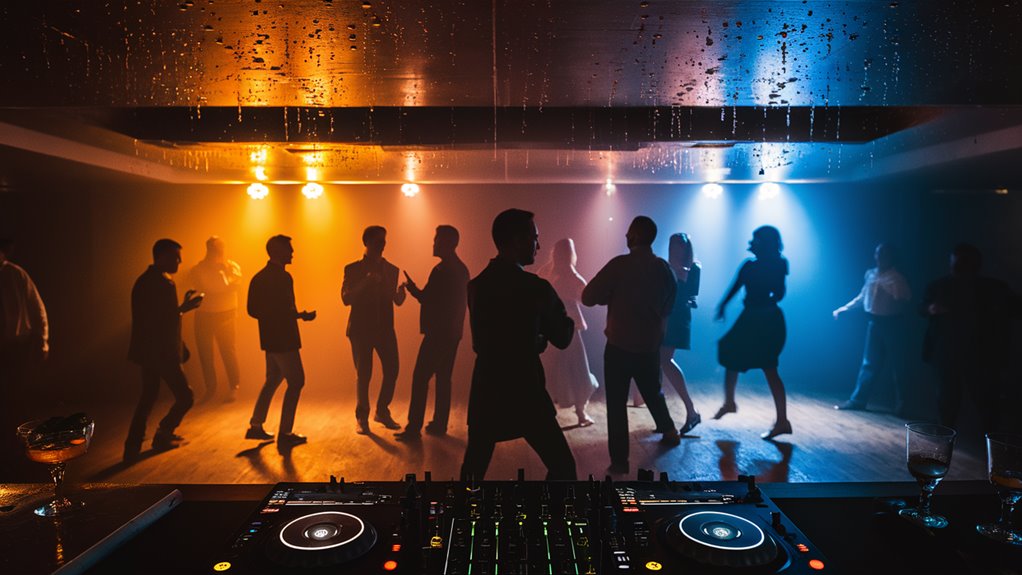Top Party Songs for New DJs: A Must-Know Guide

Key Tracks for New DJs
Dancing Queen by ABBA and I Will Survive by Gloria Gaynor are top songs that fire up the dance floor. They hit the sweet spot with a 120-130 BPM speed that gets people moving. These songs are great for new DJs, as they are sure to get a good crowd reaction and are easy to mix.
Modern Party Songs Basics
Play new pop songs that clock in at 90-120 BPM. Choose songs with catchy hooks and a steady beat. These tracks keep the party vibe going and let you smoothly swap between songs.
Key DJ Mixing Moves
Get these basic moves down:
- Match BPM within 3-5% difference
- Key mixing
- Control the energy level
- Smooth song switches
How to Read the Crowd
Keep an eye on three main areas:
- Main dance area
- Edges of the room
- Near the bar
Pro Tips for DJing Parties
Become a pro at managing the crowd and building the mood through your event. Know the key times, watch the crowd, and keep the tunes flowing to turn basics into a pro set.
Classic Party Songs Everyone Loves
Essential Guide to Classic Party Songs
Timeless Songs for the Dance Floor
The most iconic party anthems have stood the test of time across years and music types.
Classic dance songs like “Dancing Queen” by ABBA and “I Will Survive” by Gloria Gaynor always light up the dance floor with their catchy 4/4 beats and happy tunes.
What Makes a Party Song Great
Legendary party songs are built on key features that pull people to the dance floor. Famous dance hits like “Don’t Stop Believin'” by Journey and “Sweet Caroline” by Neil Diamond have:
- Catchy hooks
- Perfect dance speed (120-130 BPM)
- Sing-along choruses
- Clear music patterns
How Party Hits Are Made
Modern party song making seen in tracks like “Uptown Funk” by Mark Ronson and Bruno Mars use in-depth sound work to max out the dance effect. Key bits include:
- Strong drum beats
- Smart sound smoothing
- Even sound spread
- Great clarity
What Sets Apart Classic Party Songs
The most lasting party tunes have special music traits that everyone knows right away. From the famous piano tune in “Y.M.C.A.” by Village People to the solid beat in Whitney Houston’s “I Wanna Dance with Somebody,” these small details pull everyone in, making these songs a must for any killer party playlist.
Today’s Top Pop Songs
Modern Pop Hits: Full Production Guide
Must-Know Sound Design for Chart Hits
Current pop music blends dance elements with top-notch sound design.
Today’s hits often work within the 90-120 BPM zone, adding layered synth sounds and trap beats that top charts and radio.
What Goes Into Hit Pop Songs
Chart-leading songs mix a strong beat with catchy rhythms. Stars like The Weeknd and Dua Lipa push pop forward with disco-style bass and high-level production. The verse-chorus setup is key for keeping the dance floor full, while pro sound tuning and balancing prep songs for club speakers.
Putting Songs Together Right
Smart music layout focuses on clear peaks and soft spots, making a strong mood through the song. While most pop tunes use simple chord patterns, clever sound work and voice tweaking make them stand out. Changing keys and speeds help in moving the song along and keeping listeners tuned in.
Main Production Points:
- BPM Zones: 90-120
- Sound Makeup: Layered synths, fast hats
- Beat Setup: Strong beat with offbeat hits
- Sound Tuning: Club-ready smoothing and sound balancing
- Song Structure: Smart peaks and soft spots
Essentials for Hip Hop on the Dance Floor
Hip Hop Dance Floor Musts: Top Production Tips

Core Bits for Hip Hop Hits
Hip hop for dancing relies on three basics to rule the floor: deep 808 bass within 85-95 BPM, smart drum beats, and hooks that grab the crowd.
Checking Out Current Hip Hop Tracks
Travis Scott’s “SICKO MODE” is a great example of pro production, with:
- Changing speeds
- Loud bass hitting 155Hz
- Multiple beat shifts for full effect
Drake’s “Nice For What” shows off:
- Snappy bounce
- Fast hat taps at 1/16th space
- Smart use of voice cuts to engage listeners
Classic Hip Hop Sound Work
Missy Elliott’s “Work It” has:
- Unique kick hits on beats 2 and 4
- Great dance speed at 88 BPM
- Creative backwards singing
“N*** in Paris” by Jay-Z brings:
- Fast hat patterns
- Club-ready bass tones (60-80Hz)
- Perfect sounds for big speakers
Pro Mixing Moves
For smooth song changes, use:
- Harmonic mixing rules
- Camelot wheel for key moves
- Next key picks for steady energy
Getting the Crowd Right
Understanding the Crowd: A DJ’s Key Guide
Grasping Crowd Moves
Getting the crowd is central to great DJing, beyond just mixing. Master crowd watching by checking the dance floor feel, body moves, and the overall place mood.
Smart Room Checks
Use a three-part room scan:
- Central dance space: Watch main dance moves
- Room edges: Look at how people move
- Bar spot: Check how folks mingle
Look for key body signs:
- Arms crossed: Not into it
- Nodding heads: They’re feeling it
- Leaving the floor: You need to switch it up
Who’s in the Crowd Matters
Who is there really shapes how well your music picks work. Key things include:
- How old they are
- What style they like
- Cultural hints
- When they show up
- How drinks are selling
Keeping the Energy Right
Keep the vibe going with:
- Varying music types for everyone
- Steady BPM in switches
- Smart song picks when the room is full
- Data-backed song lists
Track and review winning mixes using:
- Club-specific facts
- What times work best
- How the crowd reacts
- Song response stats
Mixing Songs Like a Pro
The Ultimate Mixing Songs Guide
Key Beat Matching Tips
Exact tempo matching is basic to top-notch mixing. Start by lining up songs within a 3-5% BPM window using the pitch slider for smooth changes. Digital beat grids and waveform checks help line up beats just right.
Advanced Harmony Mixing Moves
Get good at the Camelot Wheel system to keep the music flowing well between tracks. Matching keys stops harsh sounds and keeps the energy smooth. Use Mixed In Key or other tools to check track keys before you mix.
EQ Tips for Clean Swaps
Smart frequency handling is key for neat changes. Cut low sounds (below 150Hz) on new tracks to avoid a heavy bass pile-up. Adjust EQ on mid and high sounds while keeping the volume even all through the mix.
Getting Mixing Timing and Setup Right
Change tracks 16-32 bars before new sections for the best flow. Use channel sliders or crossfader curves for seamless track blending. Watch energy build-up and song alignment to keep the dance floor hot. Add loop tricks and quick cues for sharper mixing.
Pro Mixing Steps
- Pre-listen steps: Check next tracks with headphones
- Energy alignment: Match feel between songs
- Filter sweeps: Build and ease tension in changes
- Effect chains: Use echo, reverb, and filters well
- Recording mixes: Review and better your swaps
Building the Party Mood All Night
Creating Night-Long Energy: A DJ’s Plan
Smart Energy Handling in DJ Sets
Growing the party mood needs smart track picks and perfect timing. Start with songs at 118-122 BPM in the first hour to set a welcoming feel while saving room for more energy later. Deep house and nu-disco with soft rhythms and few words set the right base.
Building Energy Right
The energy feel naturally goes up as the night moves on. A small speed up to 124-126 BPM in hour two keeps the mood up while you watch key crowd signs like how the floor moves and how busy it gets. The key busy hours (usually 1-2 AM) call for songs with strong bass and big drops, often at 128-130 BPM.
Advanced Mixing for Energy Handling
Harmonic mixing is key in energy building, making sure music flows well across changes. Focus on picking tracks with:
- Matching keys
- Sounds that go well together
- Right beat feel
- Well-managed sound ranges
- Growing tune complexity
These parts work together to make a natural, ongoing build-up that keeps dancers going while stopping them from getting too tired early. Smart use of these moves makes sure the energy stays up all through your set.


